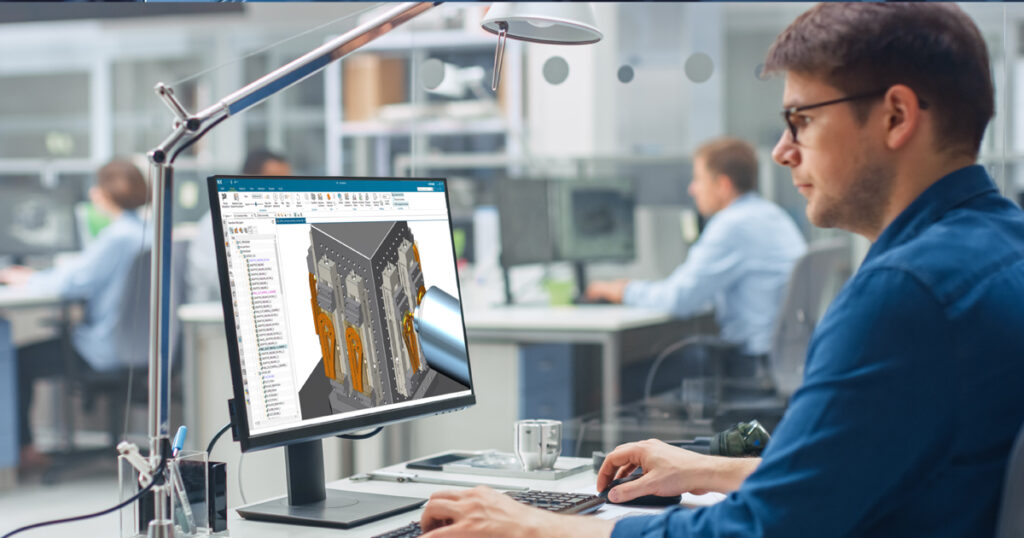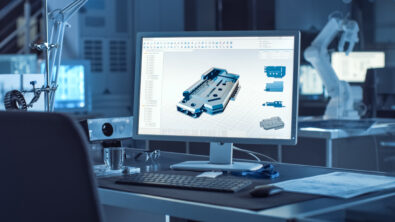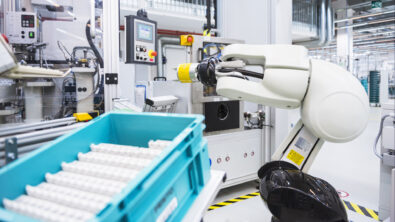Multiphysics simulation and why it’s vital to industrial machinery innovation: Podcast

Manufacturers want machines and equipment capable of higher throughputs without sacrificing quality. These same customers want these improved products delivered on tighter timelines. Lofty expectations like these demand digital solutions capable of supporting innovation and accelerating engineering processes.
Intelligent Performance Engineering from Siemens uses multiphysics simulation capabilities build more reliable, longer-lasting products. Multiphysics simulation brings a wide range of physics and disciplines together under one umbrella, so designers and engineers gain a better understanding of how different forces interact with one another.
Multiphysics simulations lets you explore all the real-world physical interaction that a complex product may encounter during use. This interaction can impact product performance, safety and last, but not least, longevity.
Giulio Camauli, Simcenter Industry Lead, Siemens Digital Industries Software
Fluid forces, thermal effects, structural integrity and electromagnetic radiation can all affect product performance, but they can also affect each other. Multiphysics simulation verifies and validates these interactions early in the process. It’s easier to remedy any issues or problems before a product reaches the customer.
In this podcast, Bill Butcher, Rahul Garg and Giulio Camauli from Siemens Digital Industries Software take a deeper look at multiphysics simulation within the Intelligent Performance Engineering solution. These three experts explain what multiphysics simulation is, discuss the benefits, and look at what one company was able to accomplish once they incorporated multiphysics simulation into their processes.
Listen to the podcast
In our last podcasts, we talked about the evolution of technology within the machinery industry, and the key trends that continue to shape the industry today. We also introduced the intelligent performance engineering solution at a high level where Rahul brought up the three key differentiators. And let me see if I can capture them correctly. First is multiphysics simulation. And Rahul you talked about balancing multi-attribute engineering to bring a wide range of physics and disciplines together under one umbrella. You also reference integrated design and simulation, which allows you to design to commission and beyond. And designers and simulations can use the same models in one system and keep that simulation data in sync. And you also referenced closed-loop validation where we’re able to validate simulations by capturing and testing their relationship between requirements, functional layout, logical implementation, and physical implementation.
So in this session, I think I’d like to take a deeper dive into the conversation of one of the differentiators: multiphysics simulation. Giulio, for our audience, what exactly is multiphysics simulation, and how has it been integrated into the industrial machinery industry?
Giulio Camauli: Yes Bill, so we have to say that as new materials and methods of manufacturing are being implemented, products are becoming more complex. The products must be lighter and smaller and work harder than ever. That is the requirements that you receive from the – people receive from customers from the market.
And multiphysics simulations lets you explore all the real world physical interaction that a complex product may encounter during use. This interaction can impact product performance, safety, and last but not least, longevity. Fluid forces, thermal effects, structural integrity, and electromagnetic radiation can all affect the performance. If you isolate these forces and examine them separately, you may not get an accurate prediction of product behavior. You have to consider all those loads at the same time during the real usage simulation.
Bill Butcher: So Giulio, staying with you now. We constantly hear how factories and plants around the world are looking at how digital transformation can help them innovate in response to changing customer demands. The adoption of new technologies – we talked about that in the first podcast. So let’s talk a little bit more about the current validation and analysis practices that you’re seeing in the field today. Can you elaborate on how machinery is approaching this?
Giulio Camauli: Yes, we have to take into account that one of the most important aspects of designing new industrial equipment or modifying an existing design lies in verifying and validating how it will perform before it reaches the customer. It cost defiantly less to fix a problem found out when it is being designed than later in the product development cycle. So the industrial OEMs have adopted a collection of digital simulation and analysis tools used to understand how design choices affect the performance and the failure modes for a component, a device, or the complete machine.
In the traditional approach, there are manual handoffs between design and simulation processes. Designers can often use design level simulation that can provide a baseline assessment of a design as to whether it is definitive or needs more advanced simulation. As equipment manufacturers try to deliver machines with faster cycle rates, and delivery schedules are being compressed, teams are feeling pressure to do more simulation upfront rather than test many physical prototypes and assume the physical tests are sufficient. So the answer, in my opinion, is that simulation and physical test must work together efficiently.
Bill Butcher: That’s a great point. And Rahul, it seems if you know what Giulio mentioned was that the power here is increasing these interdependencies between multiple forces. You know, which results in a more accurate prediction of part or machine behavior. As Giulio mentioned there, this could be the effect of heat generation while a machine is operating and the subsequent vibrations that may result from this heat displacement. You know, what are some additional benefits of multiphysics simulation that you see for the machinery industry?
Rahul Garg: Yeah, so the multiphysics simulation really allows for couple of things right. First of all, it takes away or reduces the need for testing and physical prototyping. So it helps you improve your overall speed for delivery, and as this high fidelity modeling gets more integrated into your into your business, it allows for better collaboration between the experts.
So one of the things that happens is each expert is looking at their own domain, and now with multiphysics simulation, we are able to get them all together. Because at end of the day, the machine is just not working under one environment, it’s working across all the environments simultaneously. So you need to be thinking about the same environment simultaneously as well. So this is what multiphysics allows you to do is bring all the relevant experts together as well to make sure that you can address the end customer needs and the situations that may be coming out.
Bill Butcher: So and this collaboration – that’s how I’m taking the phrase that you just said – this isn’t necessarily just defined to the actual manufacturing environment, right? It can be much bigger, right? We can talk about the context of how multiphysics simulation helps OEM’s and their broader supplier network connect and potentially act smarter. Can you talk a little bit about that and how this solution can help with that ecosystem and that collaboration?
Rahul Garg: One of the things that arises is as these comprehensive digital twins get built out, and you’re looking at small components or the entire machine itself. Each of those have to be evaluated for their specific characteristics. Now in many cases, those components may be provided by a supplier. But when you bring that component into your machine, you gotta make sure that that component works together in the context of the entire machine.
So this is where this collaboration becomes even more critical when you’re trying to work across not only within your own organization, but across companies as well. So this better integration between the designers, analysts and the live data can enable OEM’s to adopt much much better analysis practices and overall improve their performance while ensuring the safety, reliability, and effectively the cost-effectiveness of the machine.
Bill Butcher: And Giulio, taking what Rahul talked about a little bit, you know, I’m gonna go back to the term I think we keep using in the series, which is digitalization or the digital twin. And it’s not just the data that is connected right? It’s also the collaboration that Rahul mentioned between multiple teams and disciplines, and you alluded to that as well. So how does intelligence performance engineering leverage multiphysics simulation to do this? Could you be little more specific on the technology itself? We talked about how the process works, but how does the technology do this?
Giulio Camauli: Multidomain collaboration in simulation helps find the healthy compromises between very often concurrent performance. Just consider an example: heated roller that imposes a pattern on fabric or paper may be subject to thermal, contact, and rotational forces. The bearings might suffer disastrous problem if validation only considers contact stress but ignored thermal loads. A better approach is to find a tool where each problem can be set up on its own, and the results of those analysis can be feedback as input to the next. So by circulating the thousands of possible solutions with modification to the physical geometry, the best solution can be reached that satisfy the thermal needs of the fabric, building life and vibration all at once.
Bill Butcher: This sounds like a very complex ideal. So Rahul, I mean taking that a little further, do you have any examples of customers that have embraced this intelligence performance engineering strategy? Or implemented multiphysics simulation? And if so, what types of increases in efficiency were they able to achieve?
Rahul Garg: One of the customers I can think of is a company called Picanol. They’re a world leader in textile manufacturing machines. They make some of the best weaving machines for all of the fabric that we wear and that we use in our daily lives. Their machines are highly complex. They are trying to address many different needs.
As you can imagine, fabrics are not just made of traditional material of cotton or something. It goes on to sell bags, fiberglass material, draperies, upholsteries, car seats. So it has a varying levels of needs from end customers, and these machines, they need to be compliant enough to those end customer needs both in terms of what it can perform at the highest possible speeds and other requirements that they may have. So in this situation, the part of the whole weaving machine, they have to make sure that the structural integrity, the vibration, and thermal concentrations are well maintained.
Fabric behaves differently under different vibrations and thermal conditions. So the mechanics in this loom have to be very well managed. There are high – very high kinetic forces and very high speed movement that’s happening to deliver the fabric that we need. So these are some of the challenges that they are facing. And multiphysics gave them the ability to determine how best to reduce a lot of these challenges both in terms of addressing the speed needs, addressing the thermal needs, addressing the vibration needs.
By using many of our capabilities, Picanol was was able to enhance their remaining productivity by over 15%, get a significant reduction in that noise and vibration, and come up with some new techniques of them and how they create the driver mechanisms for the machines. Increase the fatigue life of the parts – of the repair parts – and then eliminate many prototypes that they would have had to build had they had the ability to have this multiphysics simulation capabilities.
Bill Butcher: It’s a great example, and I think it really highlights, you know, the interdependencies that we talked about and what are the benefits are when they can be simulated accurately. That’s a fantastic example Rahul. Thank you.
For our listeners, as you can tell from what we talked about today, it’s an intimidating mission to the design, validate, and manage contemporary manufacturing and assembly operations without looking at these independencies that we talked about between structural vibration and thermal considerations.
So I would like to thank again both Rahul and Giulio for speaking with me today and sharing their insights on multiphysics simulation and the intelligence performance engineering solution. And I hope you all join me again as we continue to review the solution itself and continue our discussion. In our next podcast, we’ll take a deeper dive into the topic of integrated design and simulation as we look to design to commissioning and beyond. Look forward to seeing you all there. Thank you.
Understanding multiphysics simulation and its benefits
Multiphysics simulation software allows engineers to take their product design and explore how they’ll react to certain real-world situations in a virtual environment. Different forces and loads have traditionally been tested separately, but this approach doesn’t provide an accurate prediction when two or more affect one another.
A multiphysics simulation method accounts for any interdependencies between multiple forces to provide a more accurate prediction of part, component or machine behavior. With more and more complex machinery being designed and built, multiphysics simulation is both faster and less expensive than physical prototypes.
Multiphysics simulation takes away or reduces the need for testing and physical prototyping, so it helps you improve your overall speed for delivery.
Rahul Garg, Vice President Industrial Machinery, Siemens Digital Industries Software
The biggest benefit of multiphysics simulation is the ability to deliver products faster at a lower cost. When delivering a highly complex machine to a customer, it needs to perform as intended. Fixing problems after delivery is much more expensive and time-consuming. It’s easier to verify and validate how a product will perform before it reaches the customer.
Industrial machinery companies have already invested in a collection of digital simulation and analysis tools to understand how design choices affect performance. Multiphysics simulation solutions simplify the process by doing more simulation upfront and minimizing manual handoffs between simulation teams.
How the industrial machinery industry is using multiphysics simulation
Forward-thinking machine companies have already adopted an Intelligent Performance Engineering approach with multiphysics simulation built into their engineering processes. The results have been significant improvements to industrial machines and how the companies operate.

A global textile machine manufacturer used multiphysics simulation to simulate new and different mechanics in their looms in an attempt to improve machine productivity. These machines move very quickly, so they needed to balance productivity with temperature and vibration.
After running different designs through multiphysics simulations, they were able to improve productivity by over 15 percent and significantly reduce noise and vibration. Additionally, they increased the service life of many parts. They did all this with fewer physical prototypes.
Learn more about Intelligent Performance Engineering in this podcast series
The embedded video above is the second of four podcasts on Intelligent Performance Engineering. It provides an in-depth look at multiphysics simulation and how it helps machine builders and equipment manufacturers overcome the challenges they’re currently facing.
The following three episodes discuss Intelligent Performance Engineering and its other aspects:
- Episode 1: What is Intelligent Performance Engineering?
- Episode 3: Integrated design and simulation
- Episode 4: Closed-loop validation
Continue listening to Bill Butcher, Rahul Garg, and Giulio Camauli to find out how Intelligent Performance Engineering solutions can help the industrial machinery industry continue to improve how it’s building new and innovative products in an evolving marketplace.

